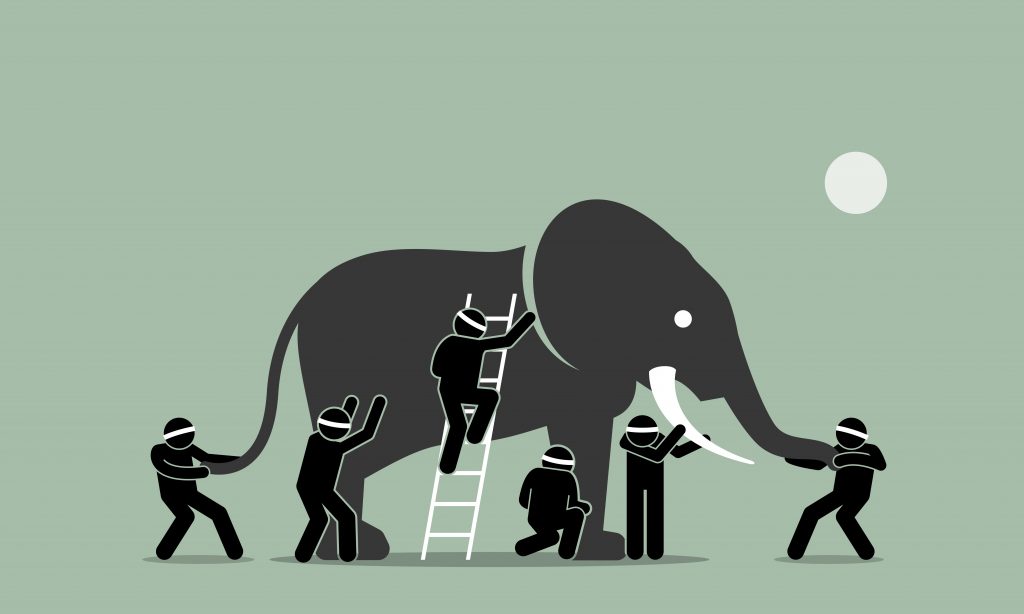I’m sure you’ve heard the ancient parable about the blind men and the elephant.
It’s the story of a group of blind men who encounter an elephant for the first time. They all touch a different part of the animal, then draw different conclusions as to what they’ve experienced. In some versions of the story, the men violently disagree and almost come to blows. The moral of the story, of course, is that people often form different conclusions based on a partial view of the same information.
This is precisely the challenge many companies have when collecting, analyzing and actioning their customer data for customer insight. How best to link multiple sources of data to capture a complete, holistic picture of the customer experience?
Islands in The (Data) Stream
For many companies, views of the customer experience are functionally focused. For example, the team in charge of packaging design understands everything about the customer’s perception of their packaging. Sales knows about product features and benefits and is competition-savvy. Customer service is full of experts about everything that can go wrong with the product.
Often, especially in large organizations, each of these teams captures, prioritizes and actions different (and incomplete) data about the customer experience. However, customers don’t view each of these areas separately — their perception of their purchase experience and the company as a whole is much more holistic.
From a company-wide perspective, this functional approach is wildly inefficient. It’s hard to know what to prioritize and take action on if you’re only focused on your small area and can’t see the big picture. It can lead to competing (and sometimes conflicting) action plans, duplication of efforts, and resources spread too thin to be effective.
More Than a Systems Issue
A common theme, again in large companies, is to put the problem down to deficiencies in systems. With the mountains of data collected and stored, the refrain goes, it must be a systems limitation that prevents customer data from being pulled together into a centralized view.
It’s true that it’s difficult to consolidate disparate data sources like customer service data, transactional data or product usage. Systems issues are real enough. However, even more than systems, this is a leadership issue. Leaders must embrace the need for a complete, ‘single source of truth’ for the customer, and acknowledge that it’s worth the time, money, and organizational disruption to do it. It’s a long-term initiative and not an easy call for leaders to make, given other more pressing, short-term issues.
It may be easier for startups to implement the ‘single customer view’ as a priority than for established businesses. It’s simpler for smaller companies to build from the ground up — to agree on what data should be collected and how it will be shared and actioned. Startup mode gives these companies the luxury of building systems around the process, rather than the other way around.
Look at how Netflix has leveraged their data gathering and their understanding of the customer experience. By collecting and analyzing user preference information, the company can recommend shows they ‘know’ you’ll like based on your previous viewing habits. Moreover, armed with a holistic view of their customers, they are creating bespoke programming that’s almost certain to be a hit with their target audience.
Starting Small The Best Approach
Ironically, the optimal solution to tackling a customer view that’s too narrow is one that involves starting small and staying focused. Remember the elephant? Not that you would, but if you had to eat him, ‘a bite at a time’ is the right approach. The same goes here.
The idea is straightforward — pull together cross-functional teams and build agreement on a small number of ‘must-have’ customer data fields that you think are the most important and impactful to your business. Next, brainstorm about the best way to collect that data if you aren’t already, determine how it can be easily shared and interpreted even if it is a manual process while gaining traction with leadership/ Once the organization begins to see that there is consistency in how teams are looking at the customer experience, it is time to leverage that data and build coordinated action plans from your findings.
Once the cross-functional team has had success with limited data streams, you may see a snowball effect. Perhaps you started with a Top 5 list of must-have customer data fields, but the team can now see gaps and opportunities that lead you to expand the initiative.
While the cost benefits of this approach can be substantial — less duplicated effort means a lower cost of data collection — the real benefits to the organization are far greater.
This focused, cross-functional approach yields a single ‘true picture’ of the customer, supported across the enterprise. Stakeholders share data and analytics and execute universal programs and get-well plans. The company develops a greater understanding of the customer experience, and that understanding is the key to building deeper, more meaningful relationships with its customers.

